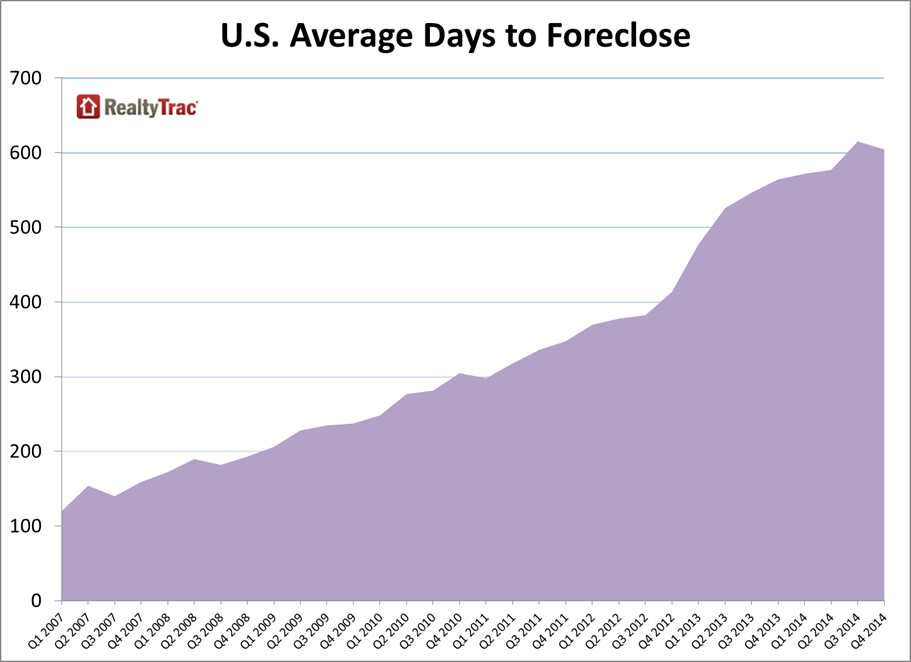U.S. Foreclosure Starts Rise to 17-Month High in December
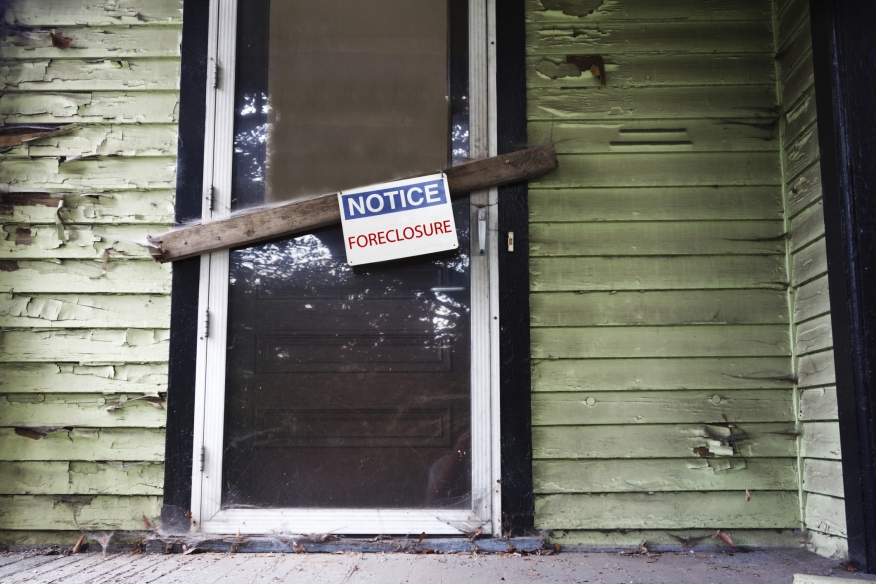
RealtyTrac has released its Year-End 2014 U.S. Foreclosure Market Report, which shows foreclosure filings, defined as default notices, scheduled auctions and bank repossessions, were reported on 1,117,426 U.S. properties in 2014, down 18 percent from 2013 and down 61 percent from the peak of 2,871,891 properties with foreclosure filings in 2010. The 1.1 million properties with foreclosure filings in 2014 was the lowest annual total since 2006, when there were 717,522 properties with foreclosure filings nationwide.
The report also shows that 0.85 percent of all U.S. housing units (one in every 118) had at least one foreclosure filing in 2014, the first time since 2006 that the annual foreclosure rate has been below one percent of all housing units.
“The U.S. foreclosure numbers in 2014 show a foreclosure market that is close to finding a floor and stabilizing at a historically normal level,” said Daren Blomquist vice president at RealtyTrac. “But a recent surge in foreclosure starts and scheduled foreclosure auctions in several states in the last few months of 2014 indicate that lenders are gearing up for a spring cleaning of deferred distress in the first half of 2015 in some local markets.”
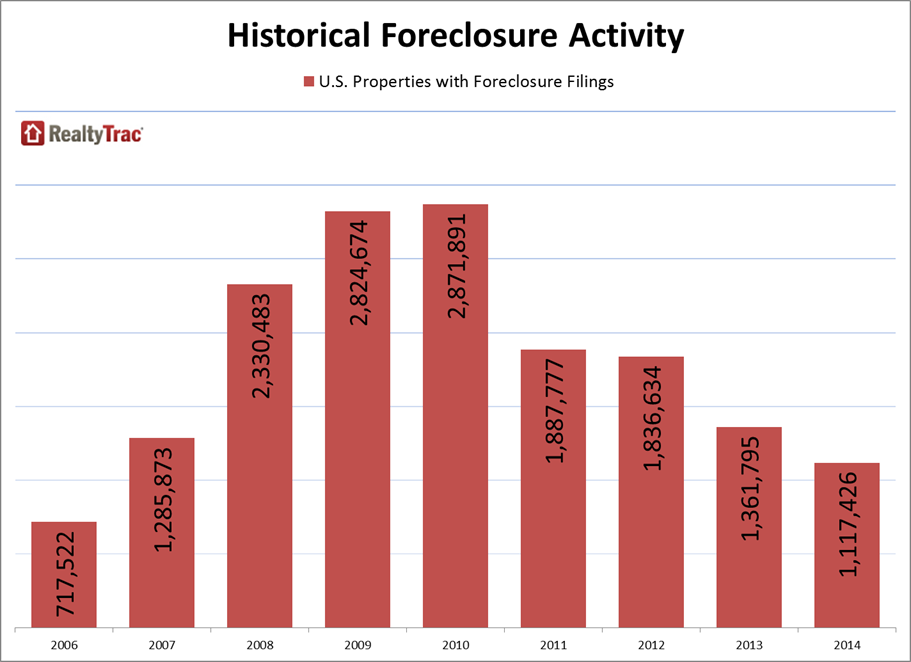
U.S. foreclosure starts in December increased six percent from the previous month and 14 percent from a year ago to a 17-month high of 59,358. December was the second consecutive month where U.S. foreclosure starts increased from a year ago following 27 consecutive months of annual decreases in foreclosure starts. December foreclosure starts increased from a year ago in 26 states, including Massachusetts (up 323 percent), New Jersey (up 262 percent), Nevada (up 194 percent), Missouri (up 88 percent), and New York (up 33 percent).
“The December surge in foreclosure starts is not a cause for concern, as it comes from a previously existing supply of distressed properties,” said Andres Carbacho-Burgos, senior economist at Moody’s Analytics, which analyzes RealtyTrac foreclosure data to forecast foreclosure trends. “The national pool of distressed mortgages has not increased despite the surge in foreclosure filings. The geographic location of the surge in foreclosure starts is not surprising. The list of states with increased activity in the last months of 2014 includes those with judicial foreclosure backlogs such as Massachusetts, New Jersey, Pennsylvania and New York. Nevada is also on the list and is not a judicial state, but still has a substantial pool of seriously delinquent mortgages relative to the years before the housing crisis.”
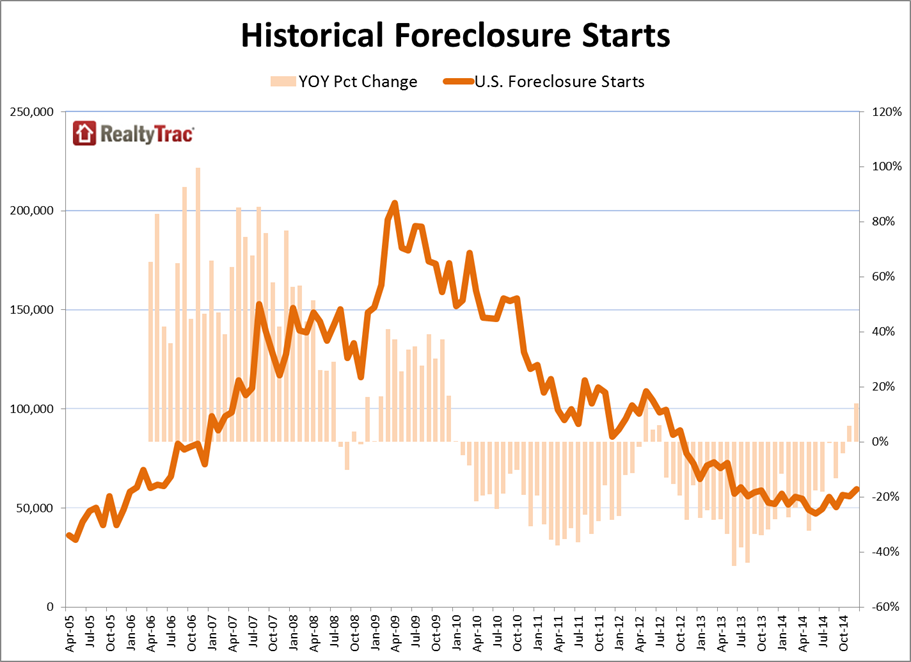
Despite the annual increase in foreclosure starts in December and November, foreclosure starts for all of 2014 were still down compared to the previous year. A total of 643,193 U.S. properties started the foreclosure process in 2014, down 14 percent from 2013 and down 70 percent from the peak of 2,139,005 foreclosure starts in 2009. Foreclosure starts in 2014 were at the lowest annual total since RealtyTrac began issuing its annual foreclosure report in 2006.
Although scheduled foreclosure auctions nationwide were down in December compared to the previous month and year ago, increases in October and November resulted in an increase in the fourth quarter compared to a year ago—following 15 consecutive quarters of year-over-year decreases in scheduled foreclosure auctions.
A total of 148,023 U.S. properties were scheduled for foreclosure auction in the fourth quarter, an increase of four percent from the third quarter and an increase of seven percent from the fourth quarter of 2013—the first annual increase in scheduled foreclosure auctions since the fourth quarter of 2010.
Scheduled auctions—which in some states are the foreclosure start—in the fourth quarter increased from a year ago in 28 states, including North Carolina (up 199 percent), Oregon (up 152 percent), New Jersey (up 118 percent), New York (up 90 percent), Minnesota (up 34 percent), and Texas (up 28 percent).
“There was an increase in scheduled foreclosure auctions in some judicial foreclosure states in 2013, and as we expected that resulted in a rising number of sales to third-party investors at foreclosure auctions in 2014,” Blomquist said. “We expect a continued high level of sales to third-party investors at the foreclosure auction in 2015 corresponding to the recent rise in starts and scheduled auctions.”
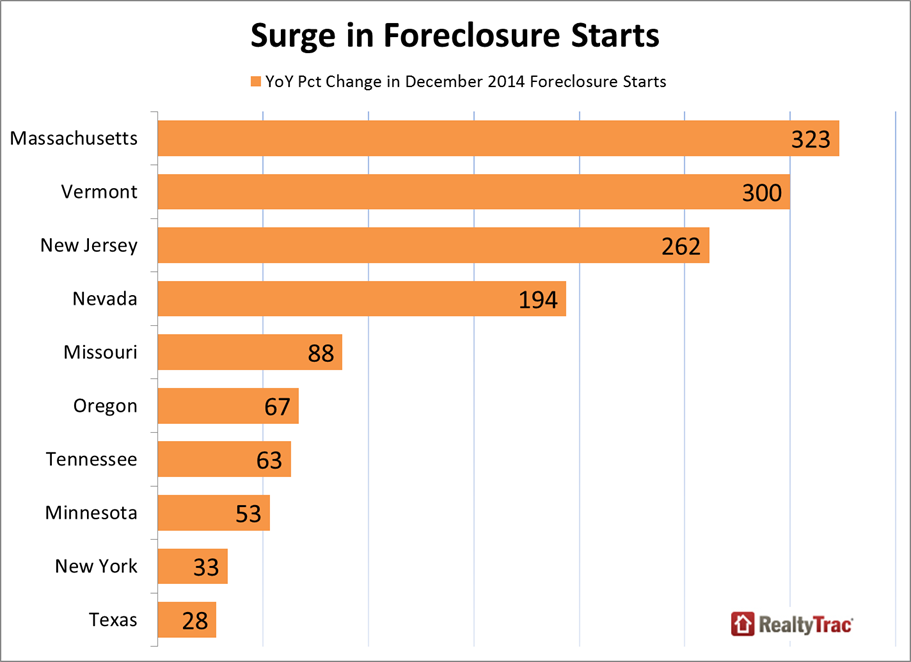
Lenders repossessed 327,069 U.S. properties through foreclosure in 2014, down 29 percent from 2013 and down 69 percent from a peak of 1,050,500 to the lowest annual total since 2006. Bank repossessions (REOs) were also down from a year ago in the fourth quarter (down 29 percent) and in December (down 24 percent).
There were nine states that bucked the national trend with increasing REOs in 2014, including Maryland (up 58 percent), New York (up 40 percent), Oregon (up 38 percent) and New Jersey (up 34 percent).
Other high-level findings from the report:
►States with the highest foreclosure rate in 2014 were Florida (2.30 percent of all housing units with a foreclosure filing), New Jersey (1.87 percent), Maryland (1.69 percent), Illinois (1.38 percent), and Nevada (1.32 percent).
►U.S. properties that completed the foreclosure process in the fourth quarter of 2014 took an average of 604 days to complete the foreclosure process, down from a record-high 615 days in the third quarter. It was the first quarterly decrease in the average time to foreclose since the first quarter of 2011.
►States with the longest average time to foreclose in the fourth quarter were Hawaii (1,067 days), New Jersey (1,057 days), Florida (946 days), New York (934 days) and Illinois (903 days). States with the shortest average time to foreclose in the fourth quarter were Texas (207 days), North Carolina (211 days), Georgia (220 days), Wyoming (230 days) and Colorado (238 days).
►Among metropolitan statistical areas with a population of at least 200,000, the highest foreclosure rates in 2014 were in Atlantic City, N.J. (3.06 percent of all housing units with a foreclosure filing), Miami (2.79 percent), Orlando (2.69 percent), Palm Bay-Melbourne-Titusville, Fla., (2.44 percent), and Tampa (2.41 percent).
►Among the nation’s 20 largest metro areas, four posted an increase in 2014 foreclosure activity compared to 2013: New York (up 31 percent), Philadelphia (up 15 percent), Washington, D.C. (up four percent), and Houston (up two percent).
►Eight of the 20 largest metro areas posted an annual increase in foreclosure activity in December: New York (up 127 percent), Philadelphia (up 57 percent), Boston (up 56 percent), Houston (up 53 percent), St. Louis (up 18 percent), Minneapolis (up 15 percent), San Diego (up 4 percent), and Washington, D.C. (up less than 1 percent).
